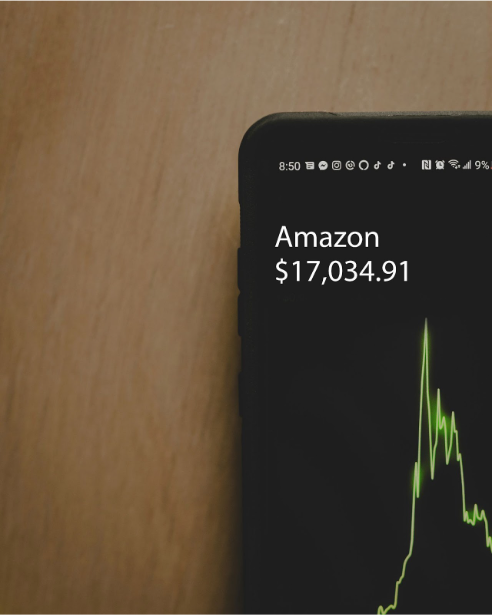- Blog
-
For Sellers
The ultimate guide to Amazon Handmade: Expert tips for artisans
Amazon Handmade helps artisans go big without going mass-produced. This guide shows you how to stand out and succeed in 2025.

Handmade goods aren’t just a cottage industry anymore. The creative manufacturing and handmade sector is estimated to have reached revenues of $1.2 trillion in 2025, showing just how powerful this market has become. Yet artisans face unique challenges: steep startup costs, lower profit margins, and fierce competition from both fellow artisans and mass-market products.
Amazon Handmade offers a solution. This dedicated marketplace gives artisans access to Amazon’s massive customer base while preserving what makes handcrafted goods special. With the right approach, you can transform your passion into a thriving business that stands out from the crowd.
Let’s dive into everything you need to know about Amazon Handmade in 2025—from qualification requirements to listing strategies that actually convert.
Don’t feel like reading? Listen to this article in our podcast, Commerce Decoded.
What is Amazon Handmade (and why it matters in 2025)
Amazon Handmade launched in 2015 as Amazon’s answer to the growing demand for authentic, handcrafted products. Unlike regular Amazon listings, Handmade is a carefully curated space where only verified artisans can sell. This creates a trusted marketplace for buyers seeking genuinely handcrafted items rather than mass-produced goods.
The platform currently supports artisans from over 80 countries but only allows storefronts in North America and Europe. That geographic focus hasn’t limited its growth, though. Amazon Handmade has expanded steadily over the past decade as consumer preference for unique, sustainably-made products continues to rise.
What counts as “handmade” according to Amazon?
Amazon has strict guidelines about what qualifies as handmade. Products must be made entirely by hand, hand-altered, or hand-assembled. You can use hand tools and limited machinery, but nothing can be mass-produced or created using automated technology or assembly lines.
This definition extends beyond just the creation process. Amazon Handmade sellers must be directly involved in designing and making their products. You can’t outsource production or dropship products made by others. This ensures the authenticity that buyers expect when shopping for handmade items.
Amazon Handmade vs. Etsy in 2025
When choosing between Amazon Handmade and Etsy, you’re deciding between two fundamentally different approaches to selling handcrafted goods. Each platform offers distinct advantages depending on your business model and goals.
Fee comparison
| Fee type | Amazon Handmade | Etsy |
| Listing fees | None | $0.20 per item, renewed every 4 months |
| Transaction fee | 15% of sale price (referral fee) | 6.5% of order amount |
| Payment processing | Included in referral fee | 3% + $0.25 (US sellers) |
| Subscription plan | $39.99/month for Professional seller account (waived for Handmade sellers after the first month) | Free basic plan; Etsy Plus at $10/month (optional) |
| Fulfillment (optional) | FBA (additional costs apply) | No in-house fulfillment service |
| Advertising fees | Pay-per-click (PPC) with keyword targeting | Onsite PPC + optional offsite ads (12%-15% commission) |
| Other setup fees | None after seller approval | <$30 one-time setup in some countries |
While Etsy’s transaction fees look lower at first glance, the costs add up through listing fees and payment processing. Amazon Handmade charges a higher referral fee but includes payment processing and doesn’t charge listing fees.
Audience and visibility differences
The biggest difference between these platforms is who shops there. Amazon Handmade customers are often general Amazon shoppers who stumble upon handmade items while browsing. They might not specifically be looking for handcrafted goods, but they’re drawn to unique products they discover.
Etsy’s audience, on the other hand, intentionally seeks out handmade, vintage, or creative goods. These shoppers value artisanal identity, storytelling, and niche products. They’re often willing to pay premium prices for unique items with personal touches.
Amazon gives you access to a massive customer base, but your products are competing with mass-produced alternatives. Etsy offers a more targeted audience specifically looking for handmade items, but the overall customer pool is smaller.
When to choose one or use both
Choose Amazon Handmade if you sell high-volume or repeatable products that don’t require extensive customization. It’s also ideal if you want to leverage Amazon’s powerful search engine and potentially use FBA for fulfillment. The platform works best for products that are easily searchable without needing deep storytelling.
Etsy might be the better choice if you’re launching a brand-focused handmade shop with highly customizable products. The platform allows for stronger branding and relationship-building with customers. It’s also perfect for testing the market with lower startup costs.
Many successful artisans use both platforms to maximize their reach. This approach works well if you can handle multichannel fulfillment and have different product types—perhaps selling small-batch custom items on Etsy while offering your more scalable stock on Amazon.
How to qualify as an Amazon Handmade seller
Unlike regular Amazon selling accounts, Amazon Handmade requires an application and approval process. This ensures that only genuine artisans gain access to the platform, maintaining its reputation for authentic handcrafted goods.
Eligibility requirements
To sell on Amazon Handmade, you must first have a Professional Selling Plan on Amazon, which costs $39.99 per month. The good news? This fee gets waived after the first month once you’re accepted into Handmade and your listings comply with their guidelines.
Amazon accepts three main types of sellers:
- Individual artisans working alone
- Small teams (fewer than 20 employees/family/friends)
- Cooperatives, non-profits, or social enterprises creating handmade products
You must have no selling restrictions on your Amazon account. This means maintaining good metrics and following Amazon’s policies consistently.
What products qualify as “handmade”
Amazon Handmade maintains strict definitions of what qualifies as handmade to preserve the marketplace’s integrity. Allowed products include:
- Handmade items created entirely by you
- Hand-altered goods that you’ve significantly modified
- Hand-assembled products you’ve put together using simple tools
- Upcycled or repurposed items that you’ve transformed
Products that don’t qualify include mass-manufactured goods, factory-produced items, third-party resold products, and dropshipped orders. You also can’t sell digital products, food/beverages, electronics, or unaltered raw materials (with some exceptions for handcrafted supplies).
Amazon Handmade supports various product categories including Jewelry, Home & Kitchen, Clothing, Art, Toys, Pet Supplies, and more. Each category has its specific guidelines, so check the requirements for your particular niche.
Documentation and proof requirements
The application process requires substantial documentation to verify your status as a genuine artisan. You’ll need to provide:
- Detailed descriptions of your design and production process
- Photos of your products that show your brand name or logo
- If applying as an organization, links to your website or proof of your organizational structure
Including links to social media or an external portfolio site can strengthen your application. Authentic, clear visuals of your workspace and creation process also help demonstrate the handmade nature of your products.
Amazon may issue conditional approvals pending your Professional Plan upgrade or additional verification steps. Be prepared to respond promptly to these requests to keep your application moving forward.
Common application mistakes to avoid
Many artisans stumble during the application process, leading to delays or rejections. Avoid these common pitfalls:
- Submitting vague production descriptions that don’t clearly explain your handmade process
- Using stock or generic images that aren’t connected to your brand
- Forgetting to upgrade to a Professional Seller account
- Listing products that fall outside Handmade’s criteria
- Misrepresenting the size or structure of your team
- Not responding quickly to follow-up emails or document requests from Amazon’s Handmade team
Taking time to prepare a thorough application with clear documentation significantly increases your chances of approval. Remember that Amazon wants to ensure you’re a genuine artisan creating authentic handmade products.
The Amazon Handmade application process
Getting started with Amazon Handmade involves several distinct steps. Understanding this process helps you prepare properly and increases your chances of approval.
Creating a Professional Seller account
First, visit sellercentral.amazon.com and sign up for a Professional Selling Plan. This plan costs $39.99 per month, but Amazon waives this fee indefinitely for approved Handmade sellers after the first month.
During account setup, you’ll need to complete several important steps:
- Provide your business and tax information
- Complete identity verification (uploading ID and bank details)
- Submit a W-9 form (for US sellers) or the appropriate tax form for your country
This process establishes your basic selling credentials on Amazon before you apply to the specialized Handmade program.
Applying for Amazon Handmade
After setting up your Professional Seller account, navigate to Amazon Handmade’s application page. This application is mandatory to access Handmade-specific tools, features, and the store.
Be thorough and honest in your answers. Amazon carefully reviews these applications to maintain the integrity of their Handmade marketplace.
Required information and images
Your application must include several specific elements to demonstrate your status as a genuine artisan:
- Photos of actual products you’ve created
- Images showing your workspace, tools, or creation process
- Clear indication of your branding (such as product tags, packaging, or signage)
Including website or social media links can help verify your presence and authenticity. Applications with generic images or vague descriptions are typically rejected, so take time to showcase your craftsmanship properly.
Current approval timeframes
The typical approval process can take up to 2 weeks (or sometimes more) if Amazon needs additional clarification. However, many artisans receive conditional approvals that require specific follow-up actions.
You might need to upgrade to a Professional plan before gaining full access, or Amazon may request additional documentation to verify certain aspects of your application. Staying responsive during this period helps expedite your approval.
How to set up your Amazon Handmade shop
Once approved, it’s time to create a compelling shop that showcases your craftsmanship and attracts customers. Your shop setup significantly impacts buyer perception and trust.
Shop profile optimization
After approval, set up your Handmade storefront through Seller Central. Add a shop name that reflects your brand, a visually appealing banner image, your logo, and a clear statement of your brand mission.
The “Maker Profile” section is particularly important, as it tells your story to potential customers. Keep visuals consistent across your banner, product photography, and logo to create a cohesive brand identity.
Rich storytelling helps build emotional connections with buyers. People purchasing handmade items often want to feel connected to the creator, so share your passion and process authentically.
Brand storytelling elements
Focus on these key storytelling fields to create an engaging profile:
- The “About You” section should share your creative journey and inspiration
- Highlight your mission and values, emphasizing your commitment to craftsmanship
- Describe your materials and techniques, noting any sustainable or unique aspects
- Mention cultural or regional inspirations that inform your work
Use compelling, human-centered language that helps customers understand not just what you make, but why you make it. This narrative creates value beyond the physical product.
Artisan profile best practices
Build trust with potential customers by implementing these profile strategies:
- Include a high-quality photo of yourself or your workspace
- Mention your location (many buyers appreciate local or regional craftsmanship)
- Write in first-person voice for authenticity (“I design…” rather than “The brand designs…”)
- Link to your social accounts for social proof
Regularly update your profile with press mentions, new product lines, or business milestones to keep your story current and engaging.
Examples of successful shops
While Amazon doesn’t publicly highlight specific Handmade shops, top performers typically share several characteristics:
- Clean, cohesive branding across all product listings and profile elements
- Seasonal collections or thoughtfully curated product bundles
- Rich imagery that showcases products from multiple angles
- Optimized bullet points that highlight unique features and benefits
- Participation in Amazon Handmade promotions and marketing events
Many successful sellers also leverage FBA to offer Prime eligibility, which significantly boosts visibility and conversion rates.
5 product listing strategies that convert on Amazon Handmade
Creating listings that turn browsers into buyers requires careful attention to several key elements. Follow these proven strategies to maximize your conversion rates.
1. Photography requirements and best practices
Your main product image must have a pure white background (RGB 255,255,255) and feature the complete product without props or text. This image appears in search results and must clearly show what you’re selling.
For additional images (up to 9 total), show your product in use, demonstrate scale, display packaging, include close-up detail shots, and create lifestyle contexts. These secondary images help customers understand the product’s size, functionality, and aesthetic appeal.
Follow these photography best practices:
- Use natural lighting or light boxes for consistent, professional results
- Ensure images are at least 1000px on the longest side for zoom functionality
- Avoid logos, watermarks, or branding on the main image (these are allowed in secondary images)
High-quality photography directly correlates with conversion rates, making this one of your most important investments.
Product description templates
Structure your product descriptions for maximum impact with this format:
- An introductory paragraph describing the product and what makes it special
- Five bullet points covering features, dimensions, materials, customization options, and care instructions
- A closing sentence reinforcing ideal occasions or uses
Keep your descriptions clear, warm, and factual without unnecessary fluff.
For example:
“Handmade ceramic mug with a speckled glaze finish. Each mug is hand-thrown and unique.
- Size: Holds 12 oz of liquid
- Material: Lead-free clay and food-safe glaze
- Microwave and dishwasher safe
- Made to order—ships in 5 business days
- Ideal for gifts, cozy mornings, and rustic kitchens
- Crafted with care in our Colorado studio.”
This template provides all the necessary information while highlighting what makes your product special.
Pricing strategies specific to handmade
Calculate your base price by including labor time, materials, profit margin, and Amazon’s 15% referral fee. Don’t undervalue your work. Handmade items can command premium prices when properly positioned.
Consider implementing tiered pricing with a base model plus paid customization options like monogramming, color variations, or size adjustments. This approach allows customers to choose their level of investment while maximizing your revenue potential.
Premium pricing works well for handcrafted goods, but you must justify it through storytelling, quality claims, and emphasizing the unique or limited nature of your products. While it’s smart to be aware of competitors’ prices, avoid racing to the bottom. Handmade products compete on quality and uniqueness, not price.
Shipping and handling time considerations
Set realistic handling times based on your production speed. Delivery windows under 14 days significantly boost visibility and sales, so aim for the fastest timeline you can consistently meet.
Always include adequate packaging time in your estimates and communicate clearly if delays occur. Transparent communication about realistic timelines builds trust with customers and prevents negative reviews.
Many successful Handmade sellers use FBA to offer 2-day Prime shipping. While this incurs additional costs, the benefits include higher conversion rates, fewer returns, and reduced customer support responsibilities. FBA works particularly well for non-customized items that you can produce in advance.
SEO optimization for handmade listings
Backend search terms significantly impact your product’s visibility. Include relevant keywords in your search fields without commas or repetition. Avoid using brand names, misspellings, or filler words. Focus on terms customers actually use when searching.
For product titles, include the main material, function, style, and occasion (up to 200 characters).
For example, “Handmade Leather Wallet — Slim Bifold for Men — Custom Engraved Gift” covers multiple search terms while remaining readable.
Use Amazon’s occasion tags to help your products appear in seasonal searches for weddings, holidays, or gift occasions. Regularly update your listing keywords to align with seasonal trends, ensuring your products appear in relevant searches year-round.
Scaling your Amazon Handmade business
Selling handcrafted goods on Amazon gives you access to a customer base that regular artisans simply can’t match. With hundreds of millions of active shoppers globally, Amazon provides immediate visibility that would take years to build independently.
There are also a bunch of tools that can simplify the process even further for you:
- InventoryLab to streamline your inventory management
- SmartRepricer to keep your prices competitive
- FeedbackWhiz Emails to automate feedback and review requests
- FeedbackWhiz Alerts to get notified about your listings and storefront
- FeedbackWhiz Profits for SKU-level profitability analysis
- InventoryLab Accounting to simplify your tax preparation
And the best part is that all these apps are part of an all-in-one bundle called Seller 365. For just $69/month, you get 10 apps to help you scale your Amazon Handmade business without breaking a sweat.
Ready to start selling on Amazon Handmade? Try Seller 365 free for up to 14 days to streamline your operations and focus more on creating.






















